Being human: two new Criterion releases
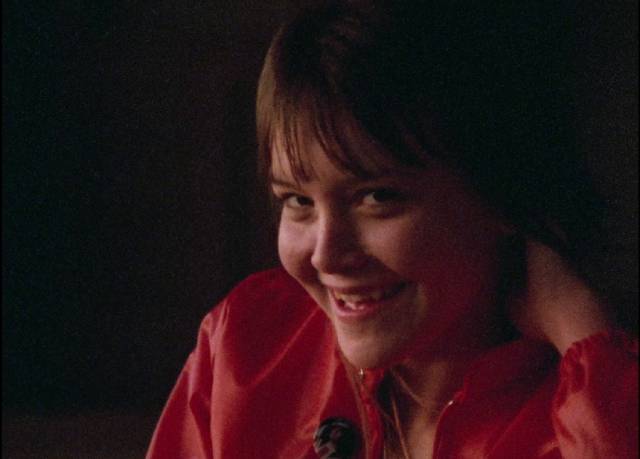
“The human condition” is something which has concerned people since we as a species became capable of thought. Art, religion, philosophy have all sought to divine answers to questions about the meaning and purpose of existence. While elaborate systems have been constructed to explain our experience, to stave off the bleak possibility that life merely is and death is the inevitable and final end, on a more immediate level “the human condition” involves our response to the physical and social world into which we are born. The idea of free will is an illusion, a myth we cling to as we are shaped and constrained by what preceded our existence and will continue once we are gone. How we navigate what we are confronted with defines our own personal sense of meaning and purpose.
Two new releases from Criterion explore the intersection of individuals with the societies in which they live; both are cinematic masterpieces, but they approach their subjects from very different conceptual directions.
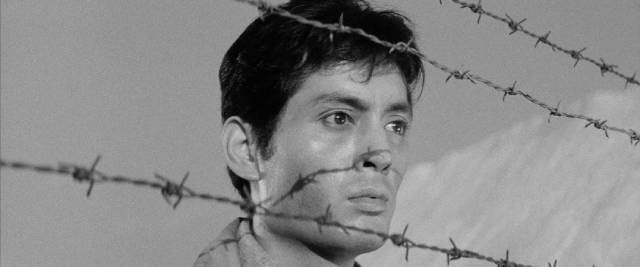
The Human Condition
(Masaki Kobayashi, 1959-61)
In ambition and scope, Masaki Kobayashi’s The Human Condition (1959-61) is genuinely epic – divided into three films, each with two parts, it consists of three distinct movements running a total of nine-and-a-half hours – yet it remains intensely intimate as it follows a single man’s efforts to remain true to himself in the midst of overwhelming historical forces which are increasingly hostile to his self-image. Kaji (Tetsuya Nakadai) was born into the militaristic society of Imperial Japan; well-educated, with leftist sympathies, he already stands at odds with his nation as it launches its aggressive assault on Asia and the Pacific in the late 1930s. The imbalance between this one individual and an entire society which believes fervently in the imperial destiny of Japan gives Kaji a quixotic quality already infused with a sense of futility. Even as we first meet him, his integrity seems compromised.
His fiance Michiko (Michiyo Aratama) wants to marry him while there’s still time, but he sees no sense in it because circumstances are so uncertain; he could be drafted at any moment. There’s no future for them. Michiko argues that what’s important is this moment, regardless of the future. Kaji only changes his mind when presented with a kind of reprieve – he’s offered a draft deferment in exchange for accepting the position of labour supervisor at his company’s mine in occupied Manchuria. He marries Michiko and she travels with him to the remote location in a harsh landscape.
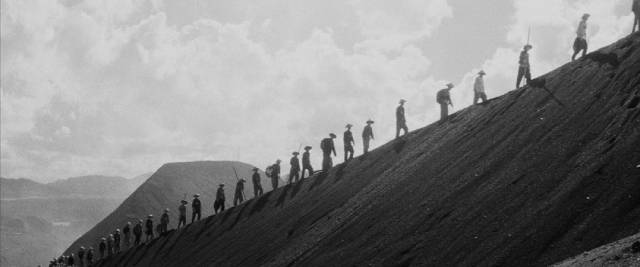
All that matters to the company and its employees is increasing the production of ore to support the war effort. To this end, they treat Chinese slave workers with extreme brutality. Kaji believes that better treatment will result in more productive workers and his efforts to improve conditions cause resentment and resistance. Things get worse when the military authorities order the company to establish a camp for Chinese prisoners; Kaji is put in charge, his humanist empathy put to an unbearable stress which sees him siding with the prisoners against his Japanese employers and co-workers. His position becomes untenable as his efforts are perceived to be disloyal by the company even as they are unable to protect the prisoners, who see his failure as a betrayal.
With the forces arrayed against him, Kaji’s best efforts are doomed to fail. Clinging to his ideals has accomplished nothing and at the end of the first part of the trilogy he is stripped of his deferment and inducted into the army. In the second part, he is more deeply embedded in the system which appalls him, yet he continues to do what he can to ameliorate the brutality of that system. Ironically, his resistance is seen by his superiors as an indication of leadership ability, but Kaji continually rejects any promotion because increased authority implicates him more deeply in the oppressive system. Put in charge of a ragged group of recruits, many of them older men ill-equipped for military life, he tries to protect them from a culture in which physical and emotional brutality is taken for granted. Men who have themselves been subjected to this brutality are eager to pass it on to those who have entered the system after them.
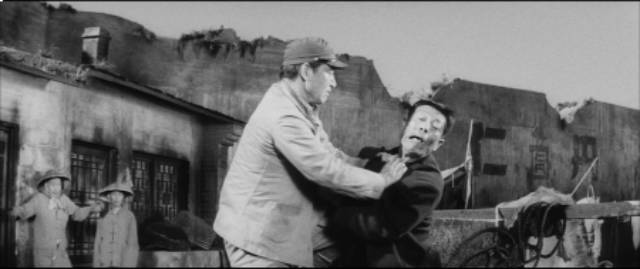
Violence permeates every level of this society and Kaji’s belief in individual worth is perceived as weakness; as he tries to protect his recruits, he himself becomes a target. As in the mine, his individual efforts to alleviate the brutality of the system are doomed to fail and those failures paradoxically lead to his being blamed for the consequences of the violence – it’s the one who tries to change things yet fails who draws the most resentment because he’s the one who raised the idea that some improvement might be possible. Kaji’s beliefs – in the value of the individual, the desirability of equality, the simple ideal of human decency – seem to carry no weight when confronted by a society which shares none of them; what then is their value? Does his personal integrity have any purpose beyond his sense of his own decency? Whatever he believes, he is undeniably a part of the system he despises.
Late in part two, when war finally reaches the remote border region of Manchuria and the Chinese army attacks, Kaji has become very much the soldier. Circumstances make this unavoidable; he has to fight while doing what he can to keep his men alive … an aim which is seemingly even more hopeless than protecting the Chinese slave labourers at the mine. He sees his men die and finds himself and the few other survivors of the tank attack abandoned by the army which is in retreat.
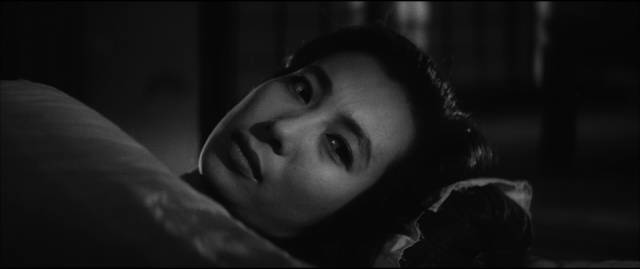
In part three, the society which Kaji has been fighting against has effectively disappeared. Wandering through Manchuria with a few other soldiers and a gradually growing group of civilian refugees, Kaji is reduced to a struggle for mere survival. The land is harsh, its sparse population hostile to remnants of the occupying Japanese forces. Although he somehow becomes responsible for the ragged mix of soldiers and civilians trying to make their way back to Japanese lines, his own concern is now his personal survival and making his way back to Michiko. The harsh realism of the trilogy’s first two parts gradually becomes more hallucinatory. Encounters with Chinese peasants and resistance fighters chip away at the group, and Kaji becomes less concerned with what happens to the others, letting go of his sense of responsibility.
Eventually taken prisoner by the Russians, in the film’s ultimate ironical twist Kaji discovers that the workers’ state he has previously idealized is as brutal and inhuman as his own society, though its cruelties are perpetrated for supposedly better reasons. After all he has tried to do – for the Chinese workers, for the recruits he trained – he finds himself condemned as a “fascist samurai” and used as a slave labourer by the communists. Unable to protect himself or others, he is finally reduced to a level of brute existence; in a harsh, protracted scene he horrifically kills another prisoner with his bare hands, an act of personal revenge, before escaping from the camp and wandering into an endless winter landscape, clinging to a now hopeless dream of rejoining Michiko as he slips into delirium and a death which erases everything he once was or hoped to be…
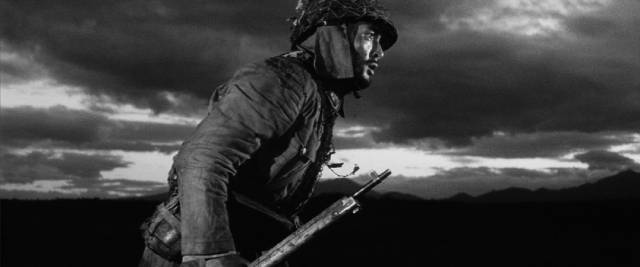
The Human Condition is a bleak, angry film, a confrontation with the horrors of Japan’s imperial ambitions which were still fresh in the nation’s memory; the militarism which was so deeply rooted in the history of a rigidly stratified society had crushed possibilities of a better, more egalitarian society, possibilities exemplified by Kaji’s ideals. While the film was based on an autobiographical novel by Junpei Gomikawa, it also reflected Kobayashi’s experiences during the war; both novelist and director were pacifist and socialist in their beliefs, both were drafted and served in the army in Manchuria, and the film’s attention to detail reflects those personal experiences.
Visually, Kobayashi uses the wide, panoramic frame to depict vast landscapes within which small human figures strive to assert themselves. There’s something heroic yet ultimately hopeless about this one individual’s efforts to assert himself against overwhelming historical forces and try to improve the lives of those around him. There’s also a paradoxical tension between the film’s deep pessimism and the creative effort it took to make it; art itself counters the hopelessness of the narrative, the act of creation a refutation of the protagonist’s defeat.
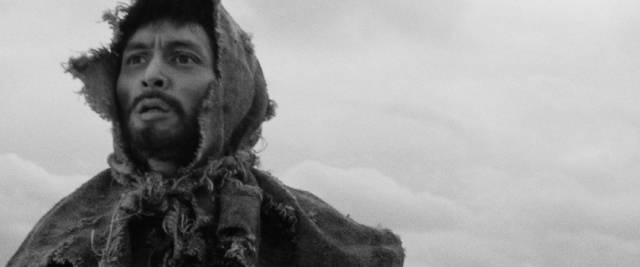
Criterion’s three-disk Blu-ray improves on their 2009 DVD edition in picture and sound quality – although there is some slight damage occasionally visible, the picture has a pleasing film-grain texture and a great deal of detail in the panoramic compositions; while the first two disks have mono sound tracks, the third disk has a 4.0 surround track which subtly adds to the increasingly hallucinatory quality of the narrative.
Although not extensive, the extras (carried over from the DVD) provide some interesting context. On disk one, there’s a conversation about the film between Kobayashi and fellow director Masahiro Shinoda (13:44); on disk two, an interview with star Tatsuya Nakadai (17:42); and on disk three a video appreciation of the film by Shinoda (24:41). Each disk also includes a trailer for that particular episode, with Shochiku promoting the project as a major event.
The booklet includes an essay on the trilogy by critic Philip Kemp.
*
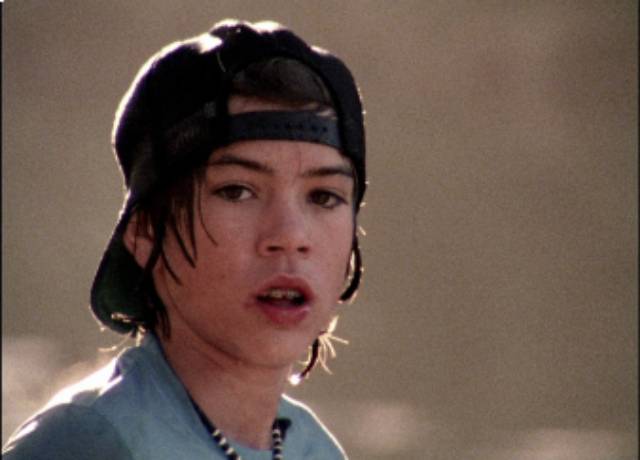
Streetwise/Tiny: The Life of Erin Blackwell
(Martin Bell, 1984/2016)
While Kobayashi is a major figure in Japanese cinema, I was completely unfamiliar with Martin Bell before Criterion announced their release of his documentary Streetwise (1984) and its kind-of sequel Tiny: The Life of Erin Blackwell (2016). To be honest, even now that I’ve seen these remarkable films, I know little about Bell – according to both IMDb and Wikipedia, he’s an American filmmaker “born in USA”. IMDb lists only ten credits, beginning with a concert film in 1983. In Criterion’s booklet, historian Andrew Hedden mentions that Bell is British and had years of experience in documentary before making Streetwise. The BFI website says that he was born in Yorkshire, and lists four dozen credits as director and cinematographer going back to 1966. The latter would explain the distinctive qualities of his first feature, a beautifully photographed, formally inventive documentary about street kids in Seattle during the Reagan years.
Streetwise began as an article for Life magazine, written by Cheryl McCall and illustrated with photos by Mary Ellen Mark. While on the assignment, Mark called Bell (her husband) and told him that there was a film to be made about the kids she was meeting. He joined her with his equipment and soundman Keith Desmond and, through the rapport Mark had established, gained remarkable, unrestricted access to a number of runaways. Shooting over a period of fifty-five days, Bell obtained a wealth of material illuminating the lives of these kids. Streetwise is a matter of small details and textures, observed with an artist’s eye and enhanced with the voices of the kids, sometimes prosaic, sometimes poetic, which accumulate to form a heartbreaking, yet sometimes exhilarating portrait of people left behind or discarded by an economic system which was touting its great successes in a thriving city.
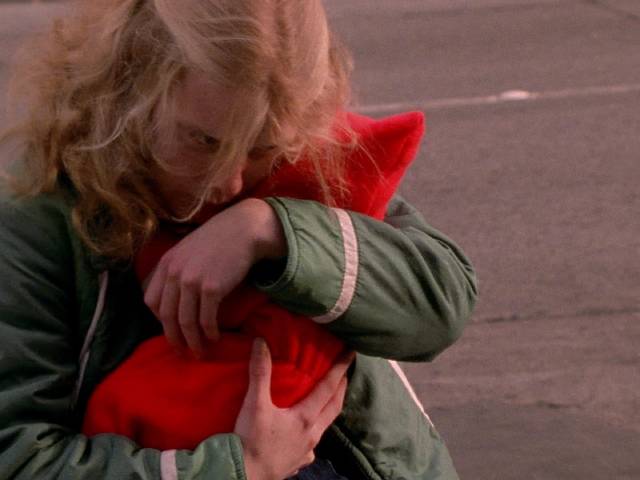
The unselfconsciousness of these kids is startling. Ranging from thirteen to eighteen, they survive by panhandling, dumpster-driving, drug-dealing and prostitution … and they seem to conceal nothing from Bell’s camera, which follows them into their littered, unheated rooms in a derelict hotel, into the offices of social workers, even into a clinic where the 14-year-old Tiny discusses her experience with STIs and the risks of getting pregnant from turning tricks. We even see Tiny getting into cars with old men looking for sex with a child. The disconnect between what we see and the casual way these kids talk about their lives is deeply disturbing, and yet the easy charm of the kids seems to speak of a heroic resilience. What is the proper response to hearing two adolescent girls chatting about being raped multiple times? Their tone somehow amplifies the horror and it’s impossible not to contemplate the depths of trauma buried beneath those smiling faces.
There’s no real narrative in Streetwise as you might find in a conventional television report on these kids; the film gradually reveals their characters through that accretion of details. Tiny emerges as a kind of protagonist through sheer force of personality. (She has an impish charm reminiscent of Giulietta Masina in Fellini’s Nights of Cabiria [1957].) In scenes with her mother, we see both friction and love; they care about each other but are not equipped to sustain a stable home. A more important connection is Tiny’s relationship with Rat, a resourceful boy with whom she seems to develop a deep emotional bond. You might call this love, though they are both still children, and towards the end when he tells her he’s leaving we’re left with an image of her devastated, so small, lost and abandoned that we realize how much of her breezy self-assurance on the street is an elaborate form of defence.
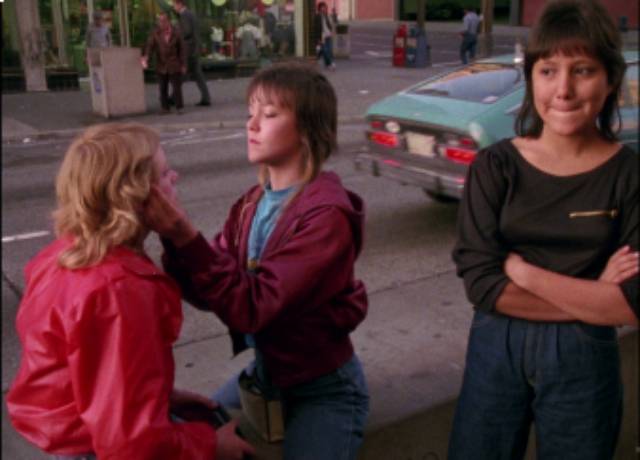
Among the others we come to know, at least to a degree, are Lulu, who takes on the role of protector looking out for the others; Shellie, who talks to her mother about being abused by her stepfather; Patrice, who seems tough on the street where he pimps some of the girls, yet becomes a shy child when he meets his mother; and Dewayne, a quiet boy who visits his father in jail and listens to admonitions about not getting mixed up with drugs and crime, and who eventually hangs himself because he just can’t stand this life any more. His father attends the pathetic funeral in handcuffs. (Bell’s subsequent feature American Heart [1992] was based in part on Dewayne and his father.)
All of this conjures up thoughts of a gritty, vérité kind of movie, but Bell has done something very different. Although of necessity much of the film was handheld, his imagery is carefully composed and often formally beautiful. (The two opening shots are packed with drama, mystery and poetry – Rat stares defiantly at the camera in close-up, then in long shot we see him climb onto the railing of a bridge; the camera follows him down in a two-hundred foot dive into a river as we hear his voice speak of the thrill of flying and the disappointment of coming “back down to the fucking world.”) I found this disconcerting at times; were these scenes being staged and constructed like a drama? It’s not only the images; even on a busy street, the kids’ voices are absolutely clear (they were individually fitted with wireless microphones). Bell’s skill with the 16mm camera allows him to do something unexpected. Rather than providing some kind of gritty exposé, Streetwise honours these kids by showing them as they see themselves instead of presenting them as objects of study, stripping them of otherness and revealing the humanity they share with us, their more privileged audience.
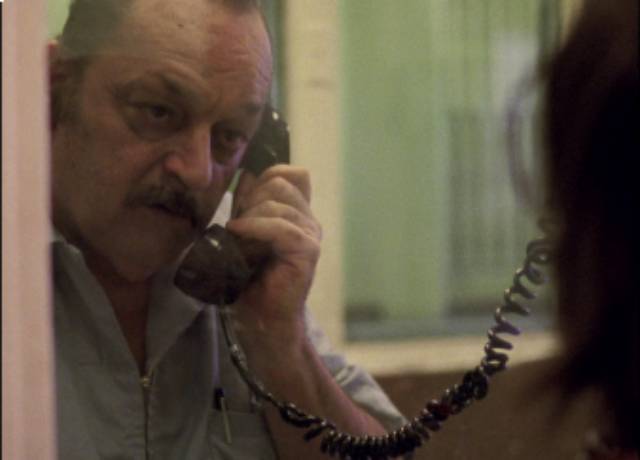
Devoid of moralizing commentary, Streetwise closes the distance between viewer and subject and in doing so indicts the society which is capable of abandoning these kids and blaming them for the abandonment.
Bell and Mark maintained a connection with some of the kids in subsequent years, in particular with Tiny, who as a 14-year-old expressed a desire to have children of her own (five boys and five girls), as if to give herself a chance to correct the horrors of her own childhood. There’s a kind of 7 Up quality to the other films included on Criterion’s Blu-ray: Bell and Mark revisited Tiny for the short films Tiny at 20 (13:43, 1993) and Erin (23:30, 2005), seeing her struggle with what we would recognize as generational trauma – she had her own children (five boys and five girls), beginning in her mid-teens, only to run afoul of a child welfare system which recognized her limitations as a mother. The older children are marked by their own feelings of abandonment, their relationships with Tiny as conflicted as hers with her own mother.
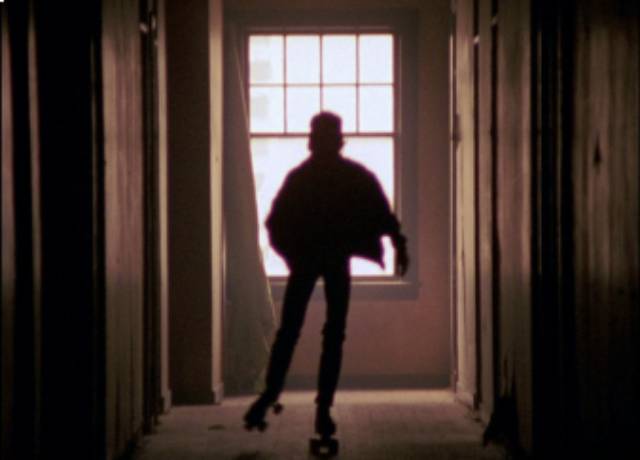
In 2015, as Mark was dying, she and Bell resumed the connection, resulting in another feature-length documentary – Tiny: The Life of Erin Blackwell. Framed by Mark and Tiny watching scenes from Streetwise on an iPad and talking about life back then and what has happened since, we can see how Tiny’s inner strength has remained in perpetual conflict with the trauma she experienced and how that has coloured her relationships with her long-time partner Will and her children. She has tried to build a home for them, but the long shadow of her life on the streets hangs over her. Her addictions affected her pregnancies (she’s now on methadone) and her kids have their own problems with addiction and the law. Yet she clings fiercely to the idea of a family life which helped her keep going back in her teens.
Although three decades have passed, Bell is still adept at capturing moments of startling intimacy and honesty. Now middle-aged, Tiny distances herself emotionally from her younger self – despite what we saw of her and Rat in the earlier film, she dismisses the idea that what she felt could possibly have been love. She was too young and immature… Strangely, Rat himself seems more deeply affected in his own short follow-up film, Streetwise Revisited: Rat (14:13, 2021). Now a family man himself, his response to the scene of him walking away from a crying Tiny is to comment that he could be a jerk … but he was just a kid himself and not equipped for the emotional demands of such a relationship.

Together, Streetwise and Tiny: The Life of Erin Blackwell offer a catalogue of the horrors facing those shut out of what a wealthy Capitalist society supposedly has to offer; they also show what it takes for these excluded people to survive as best they can. Their defeats and successes, their brittleness and resilience don’t reflect their own individual faults so much as the massive failings of a society shaped by inhuman imperatives.
In addition to the three short follow-up films, the disk includes interviews with Bell (10:22) and Streetwise editor Nancy Baker (17:27), a commentary on Streetwise by Bell which offers a fascinating look at how this remarkable film was made, plus another unrelated short film by Bell and Mark, The Amazing Plastic Lady (21:55, 1995), about another child living on the margins, this one a 10-year-old training to be an acrobat in a circus in India.
The booklet, in addition to the essay by Andrew Hedden, reprints the original Life article which inspired the film.
Comments